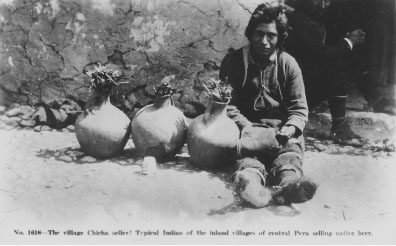Chicha, a term used in Latin America for a fermented beverage made from maize (corn). It is commonly known as chicha de jora but also goes by the names aqa in the native American language Quechua and kusa in the Aymaran language. The Spanish name comes from the word “saliva” or “to spit,” based on the method by which it is traditionally produced.
Chicha production has traditionally been the task of women in the household, with the techniques often passed down from generation to generation. The chicha maker chewed on maize to form small balls. The ptyalin enzymes in the saliva broke down the maize starches into fermentable sugars. The maize balls were left out to dry and then made into a porridge, which was strained, boiled, and fermented for 3 to 6 days in large earthenware vats.
Malted maize, called jora, has largely replaced salivated maize because it is less labor intensive to produce. Jora is made by soaking maize kernels, allowing them to germinate overnight, and then drying them. From this point, the process to make chicha with malted maize is essentially the same as with salivated maize. Depending on the region of Latin America, chicha is also often produced from yucca (cassava) root or quinoa or with the addition of various fruits.
The color of chicha varies depending on the type of maize from which it is made, ranging from pale yellow to burgundy red. When made from yellow sweet maize, it has a pale straw color and milky appearance. The beverage is slightly sour and almost cider like. It is often drunk in an active state of fermentation and has a low alcohol percentage, usually from 1%–3% alcohol by volume.
Chicha has pre-Hispanic origins in Andean South America and was an integral and key part of the Incan economy. Following the Spanish conquest in the 16th century, however, the drink was largely outlawed by the Catholic Church, which forced production underground, converting it from a large-scale industry into something smaller and more artisanal, as it remains today.
Today, chicha is still consumed at chicharias (chicha bars) throughout Central and South America. It is produced in a variety of styles, depending on the region. It is often mixed with strawberries or otherfruit to make a frutillada. The word “chicha” can also refer to a non-alcoholic beverage, chicha morada, made by boiling purple corn with cinnamon, pineapple, and cloves (which is available commercially throughout South America).
Chicha also continues to play an important social role in the more rural parts of Andean South America, where it is part of la minga (a word denoting a public group effort) and is used as a ritual payment for help given to neighbors for particularly large or complicated projects such as the construction of a new house.

Postcard of a Peruvian man selling chicha, c. 1920. pike microbrewery museum, seattle, wa
